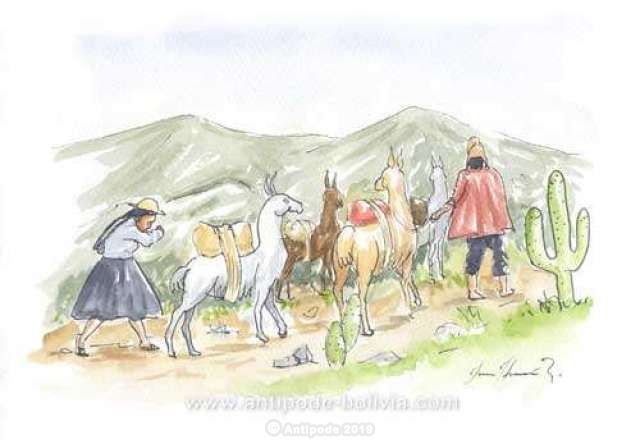

Llama caravans
A means of subsistence
The caravans of llamas were born in the pre-Columbian period, from the need for the populations living in regions difficult to access and with a climate not very favorable to agriculture to stock up on basic necessities.
It was also a way to open trade routes favoring the exchange of raw materials, and to unify in a way kingdoms (Aymara, Inca, etc.) which were not necessarily so because of a rugged geography. It was a question for the inhabitants of the north of Bolivia to cross all the Andes, once a year at the dry period (the rainy season being too dangerous), in order to go to extract salt in the Salar of Uyuni.
Accompanied by hundreds of llamas, the way is long, difficult, the animals get lost regularly, the climate is hostile. Then, once they arrive in Uyuni, the salt must be extracted in large blocks, which the llamas will then carry all the way back. The last part of the journey consists of stopping from town to town to exchange the salt for food: corn, potatoes, cereals, etc.
Finally, after several months of transhumance, return to their home village. This was a very important ritual for these populations: firstly, because it brought people from very isolated villages into contact with each other, thus sharing their cultures and customs and contributing to forming a more culturally homogenous social space. Secondly, the first caravan trip to the Salar was a real rite of passage to adulthood for the young people, testing their physical resistance and forcing them to create their own network of acquaintances in order to barter.
Unfortunately, today, these caravans have all but disappeared: the advent of trucks has made the transport of salt much more convenient and rapid, and salt is now an easily accessible commodity in all Bolivian towns and villages, so salt barter is no longer a viable practice.
However, several tourist agencies have re-created these caravans as trekking options: we re-do the same route, starting from La Paz and arriving in Uyuni, accompanied by llamas carrying our belongings, but with the economic objective less. The cultural objective, however, has remained intact. It is a privileged way to get in touch with these populations living in isolation in the lost heights of the Andes.



